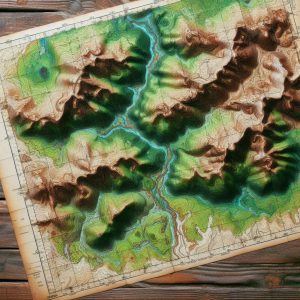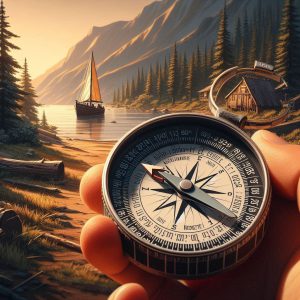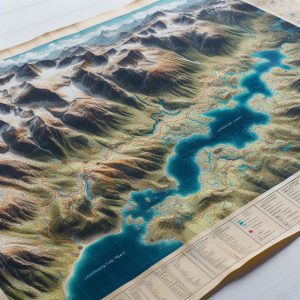Transform Your Wilderness Navigation Skills: A Complete Guide for Adventurers Without GPS
Becoming proficient in wilderness navigation without the aid of modern technology may seem daunting at first, but acquiring fundamental map and compass navigation abilities is a game-changer that can greatly enhance your outdoor experiences. At the core of successful navigation is a deep understanding of your natural environment and the capability to ascertain your position relative to your destination. A map serves as a comprehensive two-dimensional representation of the terrain, while a compass is an indispensable tool that helps you orient yourself according to the cardinal directions: north, south, east, and west. By refining your skills with these navigation tools, you can engage in outdoor adventures with newfound confidence, free from reliance on electronic devices.
To embark on your navigation journey, start by immersing yourself in the various symbols and scales that adorn a map; these components are vital for accurately interpreting the physical landscape you will encounter. A solid understanding of how to read contour lines that indicate elevation changes is crucial, as it allows you to identify hills, valleys, and various geographical features that could influence your chosen route. Moreover, becoming proficient in compass usage is equally essential, as it empowers you to navigate effectively through wilderness areas without the dependence on GPS technology.
The compass needle provides a reliable indication of magnetic north, enabling you to align your map with the actual landscape. To achieve this, hold the compass level in your hand and rotate the map until the magnetic north displayed on the compass aligns with the north indicated on the map. This fundamental technique, known as “orienting the map,” is critical for maintaining accuracy in your navigation efforts, ensuring you remain on the correct course throughout your adventure.
Once your map is correctly oriented, you can utilize the compass to take bearings that will guide your journey. By effectively merging these two potent navigation tools—the map and the compass—you will confidently traverse unfamiliar terrains, ensuring that you stay on your intended path even in the absence of modern technological aids.
Key Principles for Mastering Outdoor Navigation
- Gaining proficiency in map and compass navigation is essential for anyone involved in wilderness exploration or various outdoor pursuits.
- Topographic maps provide intricate details about the terrain, elevation variations, and natural features, which are critical for successful navigation.
- A compass not only indicates direction but also supports effective navigation by aligning with the map’s orientation and understanding magnetic north.
- Natural landmarks and indicators, such as distinctive rock formations or unique tree patterns, can serve as invaluable navigational aids when a map or compass is unavailable.
- Estimating distance and travel time is crucial for planning and executing a successful navigation strategy in the wilderness.
 The Critical Importance of Topographic Maps in Wilderness Navigation
The Critical Importance of Topographic Maps in Wilderness Navigation
Topographic maps are essential tools for anyone planning an expedition into the wild. They provide extensive information regarding the physical characteristics of the terrain, employing contour lines to illustrate elevation changes. This visualization allows you to grasp the shape and steepness of the landscape, preparing you for any challenges you may face. Each contour line connects points of equal elevation, and the proximity of these lines indicates whether the slope is steep or gentle, equipping you with the essential knowledge required for effective navigation.
Understanding Contour Lines and Map Symbols for Effective Wilderness Navigation
As you explore a topographic map, it’s vital to closely scrutinize the patterns formed by contour lines; closely spaced lines suggest steep terrain, while lines that are more widely spaced indicate flatter regions. This insight empowers you to anticipate possible obstacles along your path, allowing for informed navigation decisions. Additionally, topographic maps are rich in symbols that represent various landmarks, including rivers, roads, trails, and types of vegetation. Familiarizing yourself with these symbols is foundational for effective navigation, ensuring you can maximize the map’s potential in guiding your journey.
Perfecting Navigation Techniques with Topographic Maps
For instance, blue lines typically represent bodies of water, such as rivers or lakes, while green areas may denote forests or dense foliage. By correlating these symbols with your surroundings, you can confirm your location and adjust your route as necessary. Furthermore, topographic maps often incorporate grid lines that assist you in pinpointing coordinates, leading to even greater precision in navigation. By mastering the intricacies of topographic maps, you’ll not only enhance your navigational skills but also deepen your appreciation for the natural landscape.
 Leveraging the Compass for Accurate Directional Navigation
Leveraging the Compass for Accurate Directional Navigation
A compass is a vital tool for any outdoor enthusiast, providing essential assistance in directional navigation, especially when traversing unfamiliar landscapes. To effectively utilize a compass, start by holding it level in front of you, allowing the needle to stabilize. The needle will point toward magnetic north, which can vary slightly from true north due to magnetic declination—the angle between magnetic north and true north differing based on your geographical location.
Before embarking on your adventure, it’s crucial to determine the local declination and adjust your compass accordingly. This adjustment is vital for maintaining accurate bearings, ensuring you stay on course throughout your journey. Once your compass is calibrated for declination, you can take a bearing that will direct your path.
To take a bearing, identify a landmark you wish to navigate toward and rotate the compass housing until the orienting arrow aligns with the magnetic needle. The degree reading on the compass dial that aligns with the index line indicates your bearing. As you move toward your destination, periodically check your bearing to confirm you remain on the correct path.
If you find yourself veering off your intended course, reorient your compass and adjust your route as necessary. By mastering these techniques, you will build confidence in using a compass as a reliable navigation tool during any outdoor adventure.
 Harnessing Natural Landmarks and Signs for Effective Wilderness Navigation
Harnessing Natural Landmarks and Signs for Effective Wilderness Navigation
While maps and compasses are vital navigational tools, keenly observing natural landmarks and cues can significantly improve your ability to navigate the wilderness efficiently. Distinctive features such as mountains, rivers, or unique trees can serve as invaluable reference points when traversing unfamiliar terrain. For example, if you know a particular mountain lies to the east of your starting point, you can use it as a reliable guide to ensure you’re navigating in the correct direction.
Moreover, familiarizing yourself with the unique characteristics of your surroundings aids in forming mental maps, enabling you to navigate without solely depending on tools. In addition to prominent landmarks, be attentive to natural signs that may indicate direction or changes in terrain. The position of the sun can be a helpful guide; in the northern hemisphere, the sun rises in the east and sets in the west, providing a general sense of direction throughout the day.
Furthermore, observing the growth of moss on trees—often more plentiful on the north side—can provide valuable clues about orientation in dense forests. Animal trails can also offer directional hints; many animals follow established paths that can lead you toward water sources or other significant landmarks. By refining your ability to interpret these natural signs, you will enhance your navigation skills across diverse environments.
Strategically Estimating Distance and Travel Time for Successful Wilderness Navigation
Accurately estimating distance and travel time is crucial for effective navigation in wilderness areas. Understanding how far you have traveled and the anticipated time to reach your destination enables better planning and helps avoid unexpected challenges. One practical technique for estimating distance involves pacing—counting your steps as you walk.
On average, an adult’s stride is about 2.5 feet, meaning that by counting your steps over a known distance, you can gauge how far you’ve traveled based on your pace. Additionally, consider the type of terrain and elevation changes when estimating travel time. For instance, traversing flat ground generally allows for quicker movement compared to navigating steep hills or rocky paths.
A common guideline suggests that you can cover roughly three miles per hour on flat terrain, but this estimate should be adjusted significantly when encountering challenging landscapes. By factoring in these variables and adjusting your expectations accordingly, you will be better prepared for your journey and more capable of managing your time effectively.
Crafting a Strategic Wilderness Route and Navigation Plan
Designing Your Wilderness Route for Optimal Navigation Success
Creating an effective navigation plan is essential before setting off on any wilderness adventure. Begin by analyzing topographic maps of the area you intend to explore, pinpointing potential routes based on key landmarks, existing trails, and available water sources. As you devise your route, consider factors such as elevation changes and the difficulty of the terrain; ensuring your plan is realistic and achievable is of utmost importance.
Preparing for Unforeseen Obstacles and Weather Changes
While planning your route, it’s wise to consider alternative paths in case you encounter unexpected obstacles or sudden changes in weather conditions. Having multiple options will provide you with greater flexibility during your journey and contribute to your overall safety. This adaptability is essential for a successful and enjoyable wilderness experience, empowering you to navigate any challenges that may arise seamlessly.
Crafting a Comprehensive Navigation Strategy for Success
Once you’ve mapped out potential routes, develop a detailed navigation plan that includes key waypoints. Mark these waypoints on your map and, if possible, note their coordinates to help track your progress as you navigate through the wilderness. Additionally, incorporate estimated travel times between waypoints and identify any potential hazards that may arise along your chosen route.
Ensuring a Safe and Fulfilling Outdoor Experience Through Preparation
Thorough planning and anticipating challenges significantly enhance your chances of reaching your destination while enjoying a safe and rewarding outdoor experience. A well-organized navigation strategy is vital for a successful wilderness adventure, ensuring that you can explore the great outdoors with confidence and assurance.
 Implementing Emergency Navigation Techniques for Unforeseen Scenarios
Implementing Emergency Navigation Techniques for Unforeseen Scenarios
Despite meticulous planning and preparation, unexpected situations may occur during outdoor adventures that necessitate emergency navigation techniques. One essential skill is the ability to backtrack; if you become lost or disoriented, retracing your steps can often lead you back to familiar territory. To execute this effectively, pay close attention to distinctive landmarks or features along your route, which can serve as reference points for your return.
Another invaluable technique is celestial navigation, particularly advantageous when visibility allows—especially on clear nights or sunny days when stars or celestial bodies are visible. Familiarizing yourself with prominent constellations, such as the North Star (Polaris) in the northern hemisphere, can provide guidance, as it remains relatively fixed in position while other stars rotate. By locating Polaris and determining its angle above the horizon, you can ascertain true north without relying on a compass or map.
If you have a wristwatch or smartphone available as a backup, utilizing it alongside celestial navigation can enhance your sense of direction during emergencies, helping you maintain your orientation even in challenging situations.
Advance Your Wilderness Navigation Skills: Practical Tips for Continuous Improvement
Enhancing your wilderness navigation skills requires dedication and consistent practice, but the rewards can greatly enrich your outdoor experiences. One effective strategy is to join local hiking groups or outdoor clubs, where members can share their knowledge and experiences related to navigation techniques. Engaging with seasoned navigators can offer valuable insights into best practices while providing hands-on learning opportunities across various terrains.
Another beneficial approach involves regularly practicing with maps and compasses in diverse environments—whether in urban settings or remote wilderness areas—to build your confidence in these essential skills. Set aside time for solo excursions where you intentionally navigate without technological aids; this practice will reinforce your abilities while allowing you to immerse yourself in nature. Additionally, consider maintaining a navigation journal to document routes taken, challenges faced, and lessons learned during each adventure; this reflective process will not only bolster your skills but also deepen your appreciation for navigating diverse landscapes.
By embracing these techniques and continuously refining your skills in map reading, compass usage, natural observation, distance estimation, route planning, emergency strategies, and sharing practical experiences with others, you will evolve into a more self-assured navigator, capable of thriving in any wilderness environment, even without the support of technology.
Common Questions About Wilderness Navigation Techniques
What does wilderness navigation encompass?
Wilderness navigation involves the skills and techniques necessary to determine and maintain a route through natural, often remote, and undeveloped areas. It entails utilizing various tools and methods to stay on course and safely reach a desired destination.
What traditional methods are used in wilderness navigation?
Traditional wilderness navigation methods include using a map and compass, interpreting topographic features, observing natural landmarks, and applying celestial navigation techniques based on the sun, moon, and stars.
Why might someone opt to navigate without GPS?
Many individuals choose to navigate without GPS for diverse reasons, including the desire to enhance their wilderness navigation skills, embrace the challenge of traditional methods, or prepare for potential GPS malfunctions or limited access to technology.
What are the benefits of learning wilderness navigation without relying on GPS?
Acquiring wilderness navigation techniques independent of GPS can deepen one’s understanding of the natural environment, foster self-reliance and confidence, and provide a dependable backup plan in case of technology failures or restricted access to GPS devices.
What challenges may arise when navigating in the wilderness without GPS?
Challenges associated with wilderness navigation without GPS include the need for thorough planning, the potential for human error, and reliance on environmental factors such as weather and visibility conditions.
The post Wilderness Navigation Techniques Without GPS appeared first on Survival Bite.
The Article Wilderness Navigation Techniques for Off-Grid Adventures Was Found On https://limitsofstrategy.com
The Article Wilderness Navigation Techniques for Off-Grid Explorers First Appeared ON
: https://ad4sc.com

Comments are closed